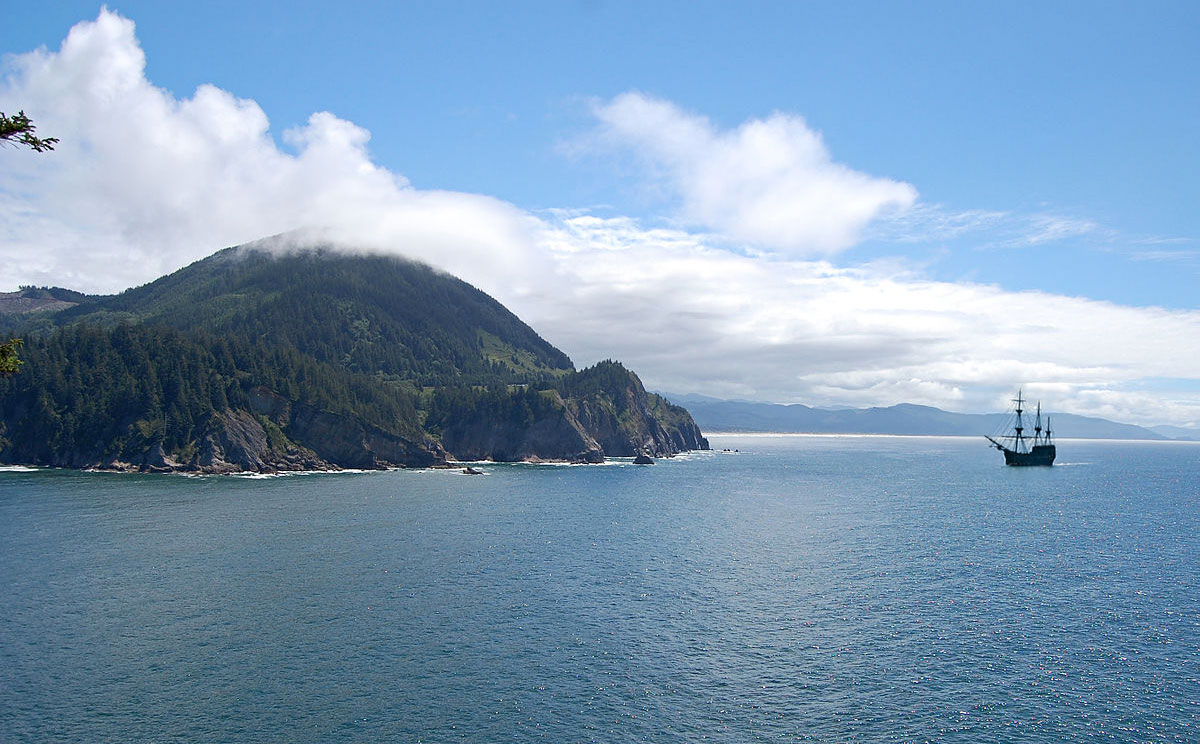 |
  
|
The Spanish Gold of Neahkahnie MountainSome believe a fabulous Spanish treasure is buried on the slopes of Oregon's Neahkahnie Mountain. Skeptoid Podcast #976  by Brian Dunning From the stormy Oregon coast in the Pacific northwest comes a tale of buried treasure. The story goes that sometime in the 1600s, a Spanish ship came into Nehalem Bay just south of Neahkahnie Mountain, where it anchored. A party of men came ashore carrying a heavy chest. They took it up the side of the mountain and dug a deep hole, then killed an African slave and dumped his body on top of the chest before filling in the hole — the dead body was to deter natives from disturbing the cache. Then they left and sailed away. The story is known because they were being watched the whole time, by indigenous people of the Tillamook tribe. Perhaps a century or so later, when the first English explorers arrived, the Tillamook told them this weird tale — and ever since, people have been digging holes all over Neahkahnie Mountain, convinced that a fortune in Spanish gold was just a few more thrusts of the shovel away. Neahkahnie Mountain is really more of a coastal headland than a mountain, part of the Northern Oregon Coast Range, with a height of only about 500m. And it's true that there has always been a problem with people digging for treasure on it, to the point that it's been nicknamed "the mountain of a thousand holes". Some have even used heavy equipment. But there is no record of anyone ever finding anything — at least, nothing valuable. Some have produced stones with nonsensical markings on them, claiming them to be clues left by the Spanish, but these claims are basically meritless and wholly arbitrary. If the story told by the Tillamook is true, then the question is who would these men have been burying a heavy chest? And what was in the chest? Those first Englishmen landed on the northern Oregon coast beginning in 1778 with the famous Captain Cook, who came in search of the Northwest Passage but instead found a lucrative trade in sea otter fur. Within 20 years there were the first settlers, and John Jacob Astor set up a trading post for his Pacific Fur Company in 1811 at Astoria. It would have been during those 20 or so years that the story was first told by the Tillamook to the settlers. Several Spanish explorers beat Cook to the northern coast of Oregon by a few years beginning with Juan Pérez in 1774, but no versions of the story appear to exist in period Spanish literature that I could find. Before 1774, no ships at all, from any nation, are known to have made it to the Oregon coast; in those days, it was a significant investment for a nation to arrange such a voyage. History leaves us no candidates for who these anonymous chest buriers could possibly have been. Could it have been pirates? Although there were plenty of pirates on the Spanish Main — the Caribbean, on the other side of the continent — they were nonexistent in the Pacific. There are many reasons for this:
Local Oregonians, however, have a theory of their own — which many of them take very seriously. They claim the famous English privateer Sir Francis Drake made landfall on the Oregon coast — thus making him, perhaps the most notorious of all pirates, a solid candidate for having paused to bury treasure on Neahkahnie Mountain. Let's see how well this conjecture holds up. Drake was on the western coast of North America in 1579, though nobody knows for sure where. He was searching for the Northwest Passage to get back to England. Having gone far enough north without finding it, he put in to shore to service his ship, the Golden Hind, for the much longer voyage west around the world. But finding no good anchorage, he continued south until he found it — south being the way he had to go to reach the equatorial trade winds. It was that brief stop before heading south that is the center of the controversy. Many coastal Oregonians insist that it was Cape Arago, just south of Coos Bay; in fact, all references I found gave this as a given fact. Their sources were all an obscure 1975 article in a periodical called Pacific Discovery put out by the California Academy of Sciences. However, with great difficulty, I got ahold of a copy (thanks to Michael Charboneau and Glenn Whelan) and it is not even remotely factual. A civic club of Drake fans in Coos Bay chose to interpret one thing Drake wrote as a possible reference to the Oregon Dunes just north of Coos Bay (that the dunes looked like snow), with no evidence at all; and apparently today it is accepted as the authoritative fact, even on Wikipedia. When Drake did land to make the repairs and careen the Golden Hind, he did so at Drake's Bay on Point Reyes north of San Francisco. From Drake's own log and the accounts of his crew, we know that they found a suitable bay and maneuvered the ship onto a shallow slope such that it would ground at low tide. From shore, the crew pulled lines attached to the masts and heeled it over far enough that damaged sections of hull could be repaired, and other maintenance done before the long voyage west across the Pacific, around the Cape of Good Hope, and home to England. They began this work on June 17 and completed it five weeks later on July 23. During the weeks of repair, the crew had friendly interactions with the local native population, and it's from the ethnographic accounts collected by the ship's chaplain, Fletcher, that we have the earliest information to help us determine what culture it was they met with, and thereby learn where along the coast they were. From linguistic and other anthropological data collected, it seems clear these were the Coast Miwok people, and the landing site was Drake's Bay along the south edge of Point Reyes north of San Francisco; specifically, a small estuary extending north from the bay called Drake's Estero. On this site, ceramics were recovered which were definitively linked to the Golden Hind by X-ray fluorescence testing in 2013. The US Department of the Interior, as well as nearly all scholars in relevant fields, now officially recognize Drake's Estero as the landing site. Drake named it Nova Albion and claimed it for Queen Elizabeth I. To accept that Cape Arago claim made by Oregonians, we'd have to accept that Drake sailed south for another 350 nautical miles before finding the first safe anchorage at Point Reyes, despite there being a number of safe anchorages between there and Cape Arago. Without reasonable doubt, the Cape Arago claim is wrong. Drake's Golden Hind could not possibly have been the ship that spent time at Neahkahnie Mountain, or anywhere else in Oregon. So if it could not have been Drake or any other pirates, who then might have inspired the Tillamook oral history of the men burying a heavy chest on the slopes of Neahkahnie Mountain? Let's go back to 1774, when Juan Pérez explored the coast all the way up to British Columbia. If we had looked way, way out to sea, we could have seen Spanish galleons making their way south since the 1500s, more than two centuries in the past. These followed the Manila galleon Trade Route between the Philippines and Acapulco. In the 1500s, galleons loaded with trade goods went north from Manila, east across the North Pacific with the prevailing westerlies, then south off the coast of North America to Acapulco. The return trip was straight across the equator with the easterly trade winds. The galleons would typically be far off the coast until they got as far south as Baja California. There are no records of any of them making landfall in Oregon or anywhere in present-day United States or Canada. Yet there were at least two that were shipwrecked. Spanish records show that only two Manila galleons were lost on that route, one in 1693 and one in 1705 — both timed very well to coincide with the Tillamook story. A very few timbers have been found, along with bits of cargo: shards of Asian porcelain, and lots and lots and lots of beeswax in blocks stamped with a Spanish mark. Plenty of that beeswax survives today, and pieces can even still be found in the sand of Nehalem Bay. Wings of bees native to the Philippines have even been found in some of it, and the wood of the timbers was confirmed in 2022 as a Philippine hardwood called molave, known to have been used in constructing the Manila galleons. These facts confirm that a Manila galleon did wreck on the Oregon coast at Nehalem Bay. Some of the wax has even been found well up in the local canyons, and for this reason, researchers have concluded that the wreck happened before the Great Cascadia earthquake and tsunami of 1700. Therefore, it is almost certainly the Santo Cristo de Burgos, lost in 1693. But did any of the crew survive to carry chests up onto Neahkahnie Mountain? There is no empirical evidence either way, but there are more stories. A fur trader from Astoria, Alexander Henry, wrote in 1813 that the local Clatsop natives had "great quantities of beeswax" to trade, and that it came from a ship whose crew had been "all murdered by the natives". Silas B. Smith, a descendant of a Clatsop chief, published an article in 1899 in the Oregon Native Son called "Tales of Early Wrecks on the Oregon Coast, and How the Beeswax Got There." It was a retelling of an oral tradition that the beeswax came from a shipwreck in which most of the crew survived, and lived with the natives for several months. But then "the whites disregarded the natives' marital relations," — meaning, in essence, they raped the native women — and the natives massacred all of them. During those months, might a few of the crew have had something they desired to preserve or protect from the natives, perhaps the ship's log, perhaps valuables, perhaps anything; and buried it on the slopes of Neahkahnie Mountain? We have no idea because there is no evidence. However, the Tillamook and Clatsop oral traditions are compatible with the empirical evidence of the Santo Cristo de Burgos, and I'm inclined to accept that version of events as the default hypothesis. Is there Spanish gold on the slopes of Neahkahnie Mountain? A Manila galleon would be unlikely to carry anything we'd consider "treasure" today; but any of our imaginations, sensing building tensions with the natives, can conceive of a desire to hide personal valuables, not just for ourselves but for our shipmates too. Is there a buried treasure on Neahkahnie Mountain? Honestly, after having done the research, I would not be surprised either way. If it does exist, it's not gold or some other treasure. it is probably a thousand times more valuable. It would be the personal mementos of a sailing crew — ignorant, illiterate, with naught more than crude pieces of art or agonizingly scripted letters to home, many years and thousands of nautical miles away — from a diminished population of sailors, tired, hurt, weakened, and knowingly under imminent execution. In proper historical context, the Spanish Gold of Neahkahnie Mountain is not a silly story to be laughed off. Rather it might be, perhaps, a very small chapter — but a poignant one — from our diverse and admirable human race. Except for the rapey part.
Cite this article:
©2025 Skeptoid Media, Inc. All Rights Reserved. |